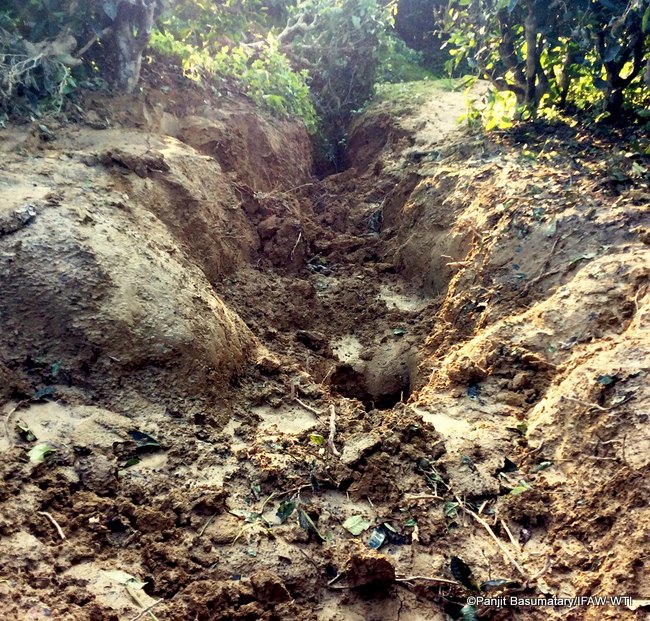CWRC’s MVS Unit Helps Reunite Elephant Calf and Mother at Behora and Numaligarh Tea Estates
Golaghat, Assam, October 17, 2016: A male Asian elephant calf that had been separated from its mother and natal herd was reunited with them by a Mobile Veterinary Service (MVS) unit of the Centre for Wildlife Rehabilitation and Conservation (CWRC; the wildlife rescue, treatment and rehabilitation facility that IFAW-WTI runs with the Assam Forest Department) last week.
The calf’s desperate trumpeting awoke labourers at the Behora Tea Estate in the early hours of October 12. The tea estate, which is located in the Golaghat district of Assam, is part of an area that has been used by resident elephant herds of the Kaziranga-Karbi Anglong landscape since their existence in the habitat.
Elephant herds are accustomed to using tea garden alleys/channels as passageways when moving through such areas. Very young calves can sometimes fall into nullahs or trenches, requiring rescue particularly when it has been raining heavily and the ground is unfirm underfoot.
Following the sound of trumpeting, the tea garden staff found the calf stuck in a trench, with its mother unable to help. They isolated the calf from the mother after a few attempts and successfully extricated it from the trench. The mother and the natal herd kept an eye on proceedings from a short distance. Once on solid ground, the calf charged at its rescuers and finally reached an area near the tea garden’s hospital, where it was restrained for its safety.
The MVS team arrived on the spot led by veterinarians Dr Panjit Basumatary and Dr Samshul Ali. On examining the calf they found that it had an external injury to its leg that had to be addressed before any thought of a wild release could be entertained.

The trench where the elephant calf was stranded prior to rescue
“The calf was sedated so that its wound could be treated”, said Dr Basumatary, who attended to the calf. “It was thereafter kept under clinical observation for a few hours and provided a rehydration supplement on the spot to stabilise it.”
Meanwhile, Dr Samshul Ali and a forest department team led by Uttam Saikia, the Honorary Wildlife Warden of Kaziranga National Park, conducted a search for the natal herd. An hour-and-a-half later, just as the calf was beginning to recover from the anaesthetic, news came in that forest guards had spotted the herd at the Numaligarh Tea Estate. The MVS team then transported the calf to a place near the herd so that a reunification could be attempted.
The calf began trumpeting the moment it was placed on the ground. No sooner had the rescue team vacated the area than the mother emerged from the forest, rushed to her baby and, having examined him, trumpeted twice and moved into the forest with him. The MVS team and forest department personnel observed the reunification from a safe distance of about 150 metres.
Rescue personnel stretcher the calf to the area where the herd had been spotted near the Numaligarh Tea Estate
The operation could not be regarded as successful just yet, however, since it has been found that reunited calves can sometimes be rejected by their herds even 24 hours or so later. The MVS team and forest guards of the Numaligarh beat monitored the area for another 72 hours, therefore, gathering evidence of the calf’s presence with the herd.
“Reuniting elephant calves with their natal herds is not an easy task”, said Dr Samshul Ali later, when it was clear that all was indeed well, “but it’s a special feeling when a herd accepts a calf in crisis back into the fold. It’s a true blessing when that happens and I’m happy to have been part of this successful reunion.”